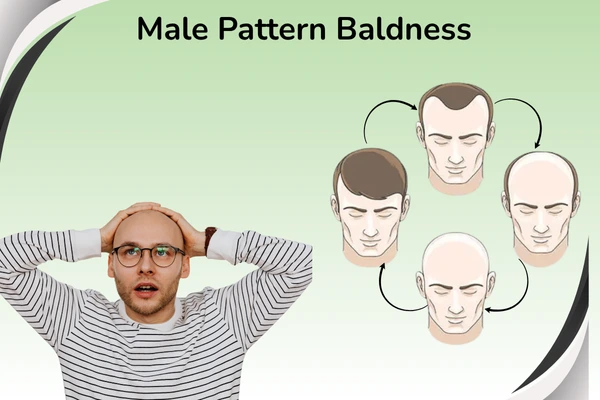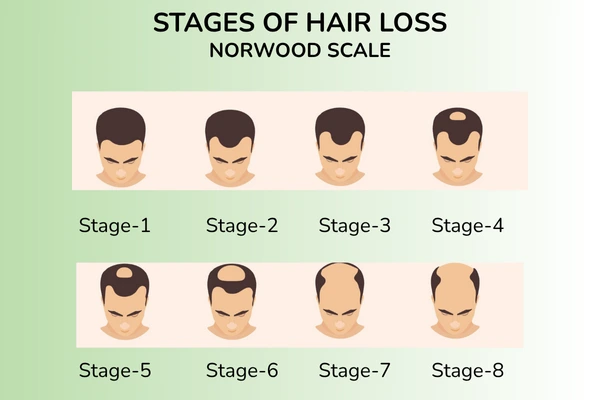Up to 25% OFF on Selected Treatments
-
Treatments
Acne and Scar
Pigmentation
Laser Hair Reduction
Dermato-surgery
Body
Anti Aging
Skin Rejuvenation
Others
- Clinics
- Blogs
Treatments
Hair is more than just a physical appearance; it plays a crucial role in shaping our identity. For many individuals, loss of hair, noticing a thinning crown or a receding hairline can be alarming signs and can significantly impact their self-esteem. In a bustling city like Bangalore, where pollution, hard water, and urban stress take a daily toll on your hair health, male pattern baldness is becoming increasingly common among young professionals and middle-aged men alike. If you have noticed subtle changes in your hairline or density and are concerned whether it is temporary shedding or the beginning of male pattern baldness, read this blog till the end.
In this blog we will explore the early warning signs and symptoms, the most common causes of male pattern baldness, exploring male pattern baldness treatment options and tips on how to prevent male pattern baldness. Whether you are just starting to notice changes or are seeking advanced treatment solutions, we are here to help.if you are based in Bangalore and struggling with hair loss, our expert led treatments like PRP and GFC have already helped hundreds od men regain confidence.

Male pattern baldness, medically termed androgenetic alopecia, is a hereditary condition that affects millions of men worldwide. The condition usually unfolds in a consistent pattern, with a receding hairline and thinning crown, ultimately leading to partial or complete baldness. Unlike temporary hair loss caused by stress or illness, male pattern baldness is usually permanent if left untreated.
Male pattern baldness is primarily driven by genetics. Men receive certain genes from their parents that increase their vulnerability to dihydrotestosterone (DHT), a powerful hormone that comes from testosterone.
DHT significantly damages the hair follicles, causing them to shrink and eventually leading to hair miniaturization. This results in hairs that are shorter, thinner, and weaker, ultimately stopping growth altogether.
It typically progresses through several hair-thinning stages:

Genetics plays a dominant role, but some causes contribute to this baldness:
We can’t eliminate genetic influences, but you can slow down or even prevent the male pattern baldness progression by:
Here are some of the male pattern baldness treatment options available:
Hair restoration treatments have come a long way, providing a range of options from non-invasive to surgical methods to tackle male pattern baldness. Among the most promising solutions are PRP (Platelet-Rich Plasma) Treatment and GFC (Growth Factor Concentrate) Treatment, both of which utilize the body’s natural healing processes to encourage hair regrowth and enhance scalp health.
PRP treatment is a regenerative approach that harnesses the healing properties of your blood to stimulate hair growth. Platelets, a type of blood cell, are packed with growth factors that promote cellular repair and regeneration. Here’s a breakdown of how PRP works and its effectiveness:
Procedure Overview:
How It Works:
The growth factors in PRP enhance the activity of hair follicles, increasing blood flow to the scalp and promoting the growth of stronger, healthier hair.
Key Benefits:
Results Timeline:
Many patients see a decrease in hair shedding after just a few sessions, with noticeable hair regrowth typically occurring within 3-6 months.
Ideal Candidates:
PRP treatment is best suited for individuals in the early phases of male pattern baldness or those experiencing hair thinning who still have active hair follicles.

GFC treatment is an advanced type of PRP treatment that offers even more effective results by isolating and concentrating the most beneficial growth factors found in your blood. It represents a significant advancement in hair restoration, leading to quicker and more dependable outcomes.
Procedure Overview:
How It Works:
GFC offers a stronger concentration of growth factors than PRP. These growth factors activate dormant hair follicles, boost blood circulation, and promote the overall health of the scalp.
Key Benefits:
Results Timeline:
Many patients notice improvements in scalp health and a reduction in hair fall within the first month. Hair regrowth typically becomes visible within 2-3 months, with the best results seen after a series of sessions.
Ideal Candidates:
GFC is especially advantageous for those looking for more significant results or individuals in the early stages of male pattern baldness.
Both PRP and GFC treatments are excellent options for restoring hair naturally. While PRP is highly effective in the initial stages of hair loss, GFC provides an advanced solution for those looking for quicker and more pronounced results of male pattern baldness.
Addressing male pattern baldness at an early stage gives you more treatment options. Methods such as PRP or medications are most effective in the early stages. Delaying treatment can lead to the need for more invasive procedures, like transplants.
If you are concerned about hair loss, consulting a dermatologist is crucial. An experienced dermatologist can precisely diagnose the underlying cause of your hair loss and recommend the most suitable treatment options based on your individual needs and medical history.
A qualified dermatologist can accurately diagnose the cause of your hair loss and recommend the most appropriate treatment plan based on your individual needs and medical history.
Dealing with male pattern baldness can be challenging, but it doesn’t have to affect your identity. By learning about the causes, spotting the early signs, looking into treatment options and following preventive steps, you can manage hair loss.
Starting early treatment is key to obtaining the best possible outcomes. For expert recommendations, don’t hesitate to contact a dermatologist. Book a consultation today and take charge of your hair health.


Visit us at:
Evenly Skin and Hair Clinic – HSR Layout
Third Floor, 815, 27th Main Rd, above Bluestone, 1st Sector, HSR Layout, Bengaluru, Karnataka 560102
Evenly Skin and Hair Clinic – Jayanagar
35, Ground Floor, Vinyas Arcade, 11th Main Rd, Vishya Bank Colony, 5th Block, Jayanagar, Bengaluru, Karnataka 560041
For health-related information, follow us on Instagram!!!
Is GFC treatment effective for male pattern baldness?
Yes, GFC treatment is an advanced treatment that isolates growth factors to rejuvenate hair follicles.
Does smoking worsen male pattern baldness?
Smoking reduces blood flow to the hair follicles, which can speed up the process of hair loss.
Does male pattern baldness affect women?
A similar condition, female pattern hair loss, affects women but follows a different pattern.
Is baldness linked to testosterone levels?
DHT sensitivity, a form of testosterone, plays a key role in baldness, not the testosterone levels themselves.
When should I see a dermatologist for male pattern baldness?
Seek a dermatologist’s advice as soon as you notice the early stages of hair thinning to discuss potential treatment options.
Does scalp hygiene affect male pattern baldness?
Maintaining a clean scalp promotes healthy hair growth but doesn’t prevent genetic baldness.
How does hair thinning differ from male pattern baldness?
Hair thinning is a general reduction in hair density, whereas male pattern baldness follows a specific pattern of hair loss.
We hope this information is helpful. If you have any skin and hair-related questions or would like to discuss personalized solutions, please reach out to us at 7337899030. Our team of experts is dedicated to providing personalized care that meets your unique needs. Take the first step towards a healthier, more confident you by scheduling a consultation with us today. Your journey to vibrant skin and stronger hair begins here.
Book an Appointment
Start your journey to healthy skin and hair today.
Leave a Comment